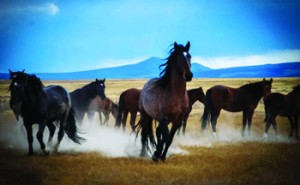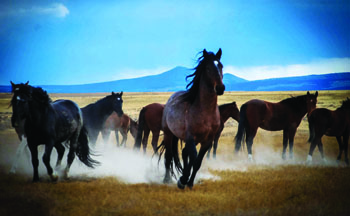
A roan mustang stallion crests a hill in Utah’s range country. He views his herd of mares, paws the sandy desert ground and sniffs the air. He smells no predators, but he cannot smell the danger looming in the future.
People travel from all over the country to Utah hoping to catch a glimpse of its wild horses. The mustangs are the descendants of horses brought to the new world by the Spaniards, and have roamed free ever since. A breathtaking sight to behold, mustangs have long been an inspiration to artists and those who dream about the freedom they represent. They travel in herds, and spend their time running, feeding, playing, and occasionally scuffling with each other.
Cris Draper knows these horses well. His parents introduced him to the wild mustang population when he was only six years old. Now, as president of Trail Master Outdoors INC., he’s working to save them.
A large portion of the wild horse population is being held in facilities by the Bureau of Land Management, which Draper says is unfair not only to taxpayers, but to the mustangs themselves.
I shudder at what I’ve seen at some of the facilities, the inhumane way they’re penned up and standing up to their knees in muck. No piece of our wild heritage should be treated like that.
Chris Draper
Even worse, the mustang population may soon face an even more sinister fate. Draper says the government is once again considering slaughtering the mustangs.
“For years, they were shipped across the border into Mexico and Canada to be slaughtered, because it was outlawed for them to be slaughtered here. I’m afraid we’re looking at those days same again.”
Draper said most of the actions taken against the mustang population are due to misinformation. Because the mustang population is not native to Utah, some assume that they are damaging to the environment. However, Draper says the horses are no more damaging than cattle, and are actually less damaging than sheep. When sheep consume vegetation, they will sometimes pull a plant up by the roots in order to consume it, while the mustangs eat only the part of the plant that grows above the ground.
Some believe that food sources here in Utah are too scarce for the horses, but that doesn’t add up with what Draper sees. Draper is unable to even keep his own domesticated horses looking as healthy as Utah’s general mustang population, and he notes that the odd mustang or two that appears emaciated usually does so due to an illness, rather than a lack of available nutrients.
But it’s not just the mustangs that are suffering as the result of the governmental policies, but people who are missing out on witnessing an inspiring piece of history.
“They’re a national treasure. They go back to the Spanish conquistadors and the Pony Express” says Draper.
Draper encourages people to get involved in the struggle to save the mustangs. “It’s an iconic piece of our heritage and very few people ever get the chance to experience the sound and the visual look of seeing those mustangs run across the prairie,” said Draper.
For more information contact mustangheritagefoundation.org or savethemustangfoundation.com






